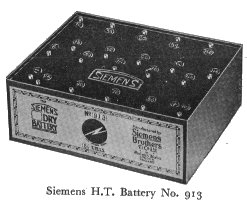Batteries

The first valve radios were mainly battery powered, as mains electricity reached homes battery sets slowly became popular apart
from portable sets. (Although the first mains powered receiver appeared no later than 1925).
 Many can remember taking the lead acid accumulator that powered
the valve heaters to the radio shop to be recharged. Accumulators
were sometimes know as the storage battery. A popular
British brand was Exide made by the Chloride Electrical Storage
Company.
Many can remember taking the lead acid accumulator that powered
the valve heaters to the radio shop to be recharged. Accumulators
were sometimes know as the storage battery. A popular
British brand was Exide made by the Chloride Electrical Storage
Company.
A Table of Capacity of the WJ Exide Accumulator
| Current in milli-amps |
2.5 |
5 |
10 |
25 |
| Running Hours |
1,000 |
440 |
200 |
60 |

 In addition to the low voltage accumulators the radio sets of the day required a HT (High Tension) battery to provide a low current
high voltage supply. Such batteries may have lasted 9 months before
being discarded. HT batteries had taps for taking different voltages. High voltages could be provided from either a single
large battery or for 180V three series connected 60V HT batteries
were used.
In addition to the low voltage accumulators the radio sets of the day required a HT (High Tension) battery to provide a low current
high voltage supply. Such batteries may have lasted 9 months before
being discarded. HT batteries had taps for taking different voltages. High voltages could be provided from either a single
large battery or for 180V three series connected 60V HT batteries
were used.
Some sets used a separate grid bias battery available in 4.5, 9 and 18V sizes.
Trivia Quiz:
What was a coherer?
 |
Home |
Reference |
Featured Radios |
Radio Books |
UK Resources |
Radio Books |
Notice Board |
Junk |
Table of Contents |
What's New |
Crystal Sets |
Quiz |
The Galleries |
Radio Links |
1930's Magazine |
|
Home |
Reference |
Featured Radios |
Radio Books |
UK Resources |
Radio Books |
Notice Board |
Junk |
Table of Contents |
What's New |
Crystal Sets |
Quiz |
The Galleries |
Radio Links |
1930's Magazine |
Email radio@qsy.to
 Many can remember taking the lead acid accumulator that powered
the valve heaters to the radio shop to be recharged. Accumulators
were sometimes know as the storage battery. A popular
British brand was Exide made by the Chloride Electrical Storage
Company.
Many can remember taking the lead acid accumulator that powered
the valve heaters to the radio shop to be recharged. Accumulators
were sometimes know as the storage battery. A popular
British brand was Exide made by the Chloride Electrical Storage
Company.
 In addition to the low voltage accumulators the radio sets of the day required a HT (High Tension) battery to provide a low current
high voltage supply. Such batteries may have lasted 9 months before
being discarded. HT batteries had taps for taking different voltages. High voltages could be provided from either a single
large battery or for 180V three series connected 60V HT batteries
were used.
In addition to the low voltage accumulators the radio sets of the day required a HT (High Tension) battery to provide a low current
high voltage supply. Such batteries may have lasted 9 months before
being discarded. HT batteries had taps for taking different voltages. High voltages could be provided from either a single
large battery or for 180V three series connected 60V HT batteries
were used.